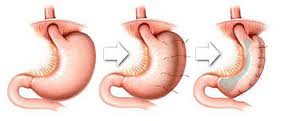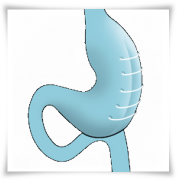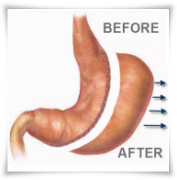Gastric Sleeve Surgery
The Gastric Sleeve Surgery, otherwise known as a gastric sleeve resection or a vertical sleeve gastrectomy, is a restrictive weight loss procedure. Gastric sleeve surgery involves reducing the size of a patient’s stomach which limits the intake of food while lessening the hunger sensation. This procedure does not entail food malabsorption or rerouting of the intestines.
Click here to read more about Gastric Sleeve Weight Loss.
The gastric sleeve surgery process has been duly recognized as one of the most successful bariatric procedures, but it is not the latest kind of surgery for losing weight. It has already been done by a lot of bariatric doctors for some time now; however, this is just the first stage of a two stage procedure between the gastric bypass and the duodenal switch surgery later on.
The rationale of the two stage method is to make the weight loss procedure safer for those patients who are high risk, predominantly those patients with a body mass index of more than 50-60 and those with health ailments that will not allow them to undergo a single or combined malabsorptive and restrictive surgical procedure. In these cases, gastric sleeve surgery is performed first, then the patient loses weight, and the health risks are much lower for the second stage.
Gastric Sleeve Surgery – About The Procedure
Recently, more bariatric surgeons are performing gastric sleeve surgery as a single stand-alone surgery. With this latest approach, the patient’s stomach pouch is generally made narrow, more so than the typical duodenal switch patient. Long term results of gastric sleeve surgery are still not available, but the results for short term results are favorable, particularly for patients with low a Body Mass Index (35 to 45).
 During the procedure, the surgeon may make one large incision, or a few smaller incisions to access the stomach. The surgeon will then remove 60% to 80% of the patient’s stomach tissue from the greater curvature, which leaves a small tube, or a “sleeve shaped” stomach which serves as the new stomach pocket. The new stomach is then stitched closed, and the patient is closed back up.
During the procedure, the surgeon may make one large incision, or a few smaller incisions to access the stomach. The surgeon will then remove 60% to 80% of the patient’s stomach tissue from the greater curvature, which leaves a small tube, or a “sleeve shaped” stomach which serves as the new stomach pocket. The new stomach is then stitched closed, and the patient is closed back up.
One major factor to consider is that gastric sleeve surgery involves removing part of your stomach. Once it has been removed, it cannot be put back.
Gastric Sleeve Surgery is Permanent
The new stomach pocket expands from the patient’s natural stomach opening down to the stomach outlet, or the pyloric valve, both of which have not been altered. No other changes are made, the stomach is simply made smaller. Since the stomach can hold less food, the gastric sleeve surgery will help the patient to lose weight.
The decreased size of the stomach also helps to manage hunger because the patient will become full with less food. Additionally, the part of the stomach which produces Ghrelin (the hunger hormone) is removed which further reduces the patient’s appetite.
In general, gastric sleeve surgery is much less complicated compared to the gastric bypass and the duodenal switch surgery, given that the small intestine and the pyloric valve are left intact. Furthermore, the gastric sleeve procedure does not engage in implanting a medical tool or any type of foreign object inside the body to control food consumption, as with the gastric banding procedure.
Gastric Sleeve Surgery – Expected Results
Those who have undergone gastric sleeve surgery as the primary procedure will normally expect to lose about 30-50% of their extra weight over the next 12 months. This primary weight loss will make the second stage of the surgery (if required) safer, which will either be a duodenal switch surgery or a gastric bypass, both of which generally involve rerouting the patient’s small intestine. The schedule for the second weight loss surgery will depend upon the pace of weight loss after gastric sleeve surgery.
The short term results of the gastric sleeve surgery show that patients typically lose 60% to 70% of their extra weight within a period of 2 years. A long term effect has not yet been established as the stand-alone gastric sleeve surgery approach is relatively new. However, if the weight loss is inadequate after the initial procedure, then a malabsorptive bariatric surgery such as a duodenal switch can be performed in order to encourage additional reduction of weight following gastric sleeve surgery.

